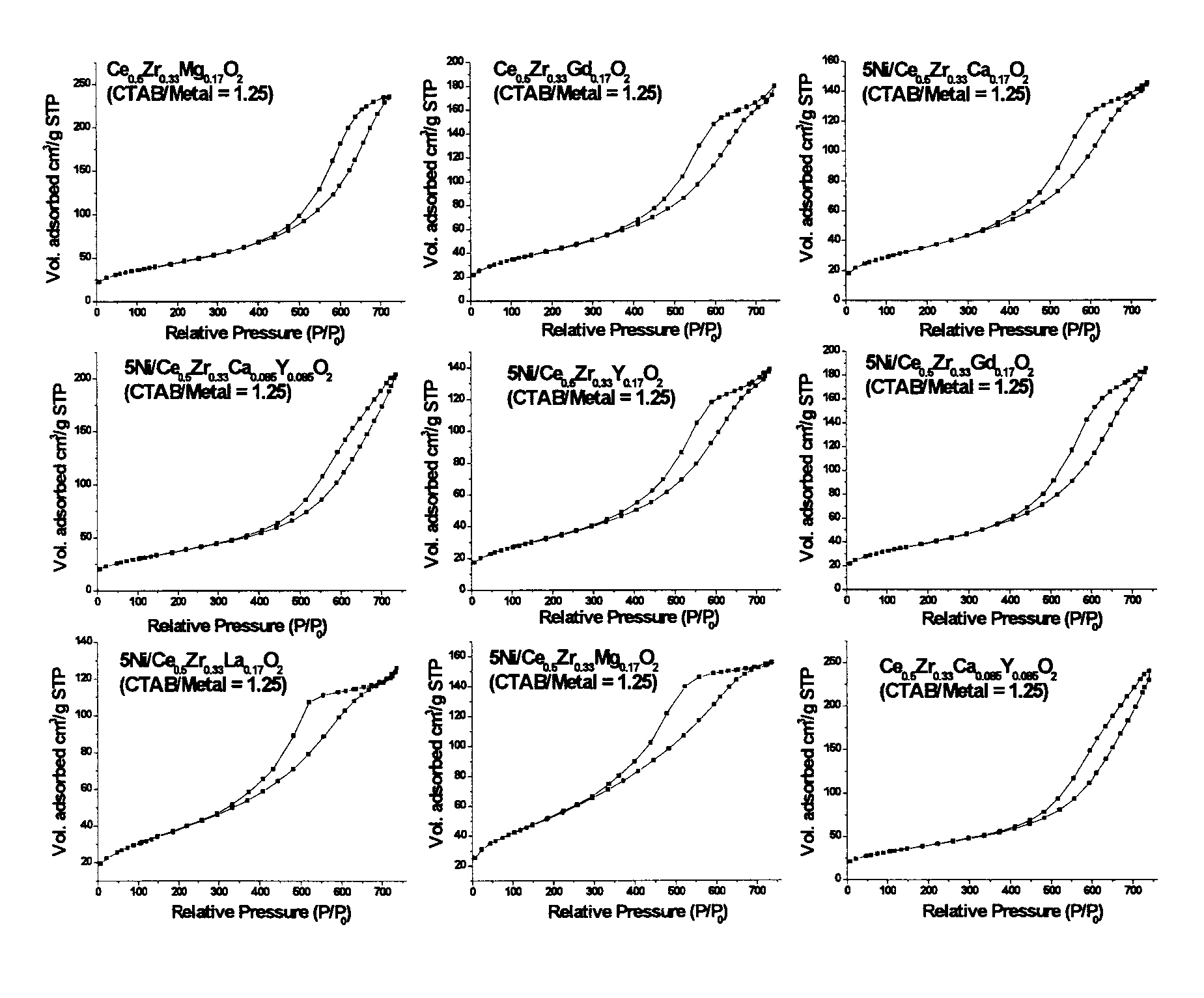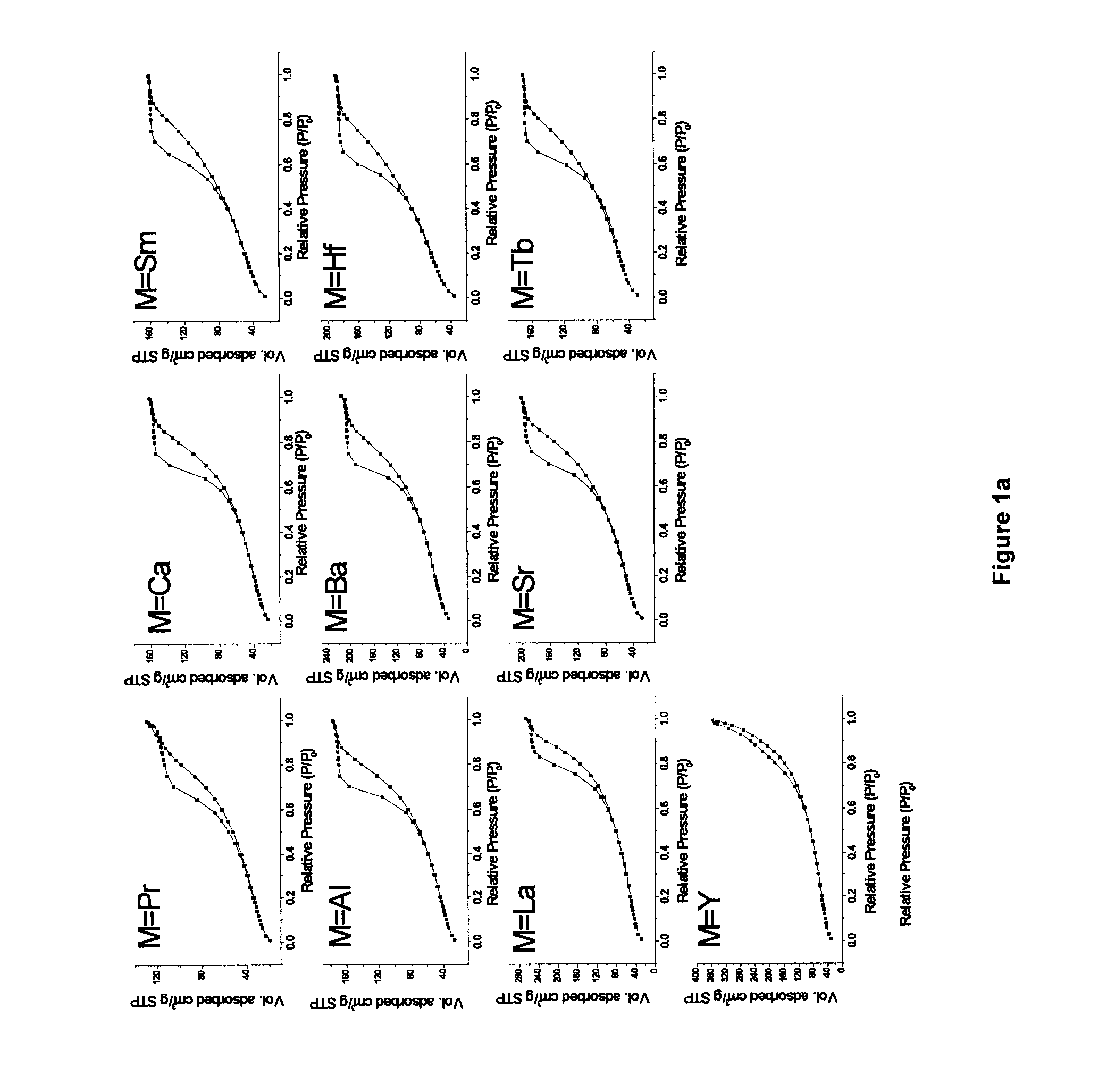Catalysts for feedstock-flexible and process-flexible hydrogen production
a technology of catalysts and hydrogen production, applied in the field of catalysts, can solve the problem of small catalyst needed per unit amount of hydrogen produced, and achieve the effect of high activeness
- Summary
- Abstract
- Description
- Claims
- Application Information
AI Technical Summary
Benefits of technology
Problems solved by technology
Method used
Image
Examples
example 1
Preparation of Ternary & Quaternary Mixed Oxide Supports
[0108]The synthetic route employed in the study, is based on a modification of a ‘surfactant assisted route’ used by Idem et al. [2006] for binary oxide supports [21], wherein nitrate salts of different metal ions were hydrolyzed together along with a surfactant (CTAB) under basic conditions, and subsequently aged hydrothermally under autogenous pressure at 90° C. for 60 h. The CTAB / [Ce+Zr] ratio of 1.25 was used in the previous report [21]. In most of the current work, the surfactant (CTAB) usage is significantly reduced by a factor of 2.5 for the purpose of minimizing wastes generated during catalyst making. This represents a much improved and optimized version of the previous recipe [21]. Binary oxide supports (Ce0.6Zr0.4O2) with CTAB / [Ce+Zr] molar ratios 0.5 and 1.25 were also prepared in the current study for comparison purposes. The two binary oxide supports prepared using two different CTAB / [Ce+Zr] ratios are abbreviated...
example 2
Preparation of Supported Nickel Oxide Catalysts
[0127]A nominal 5 wt. % Ni was loaded over the above-prepared supports (I) (refer to paragraph [00100]) by standard wet impregnation method. Similarly the binary oxide supports CZ(0.5) and CZ(1.25) were also impregnated by same procedure to yield corresponding catalysts i.e., NZC(0.5) and NCZ(1.25). In a typical impregnation 14.25 g of catalyst support (I) is immersed in 127.75 ml of 0.1 M Ni(NO3)2 solution. The mixture was subjected to slow heating under constant stirring in a hot water bath, so as to remove the excess water; the dried powders thus obtained were calcined at 650° C. in air for 3 h. The calcined catalysts are reduced in situ during the course of reaction in order to reduce the NiO species to metallic Ni species. The reduction is carried out at 700° C. in flowing 5% H2 / bal.N2.
example 3
Catalyst Characterization
[0128]a. Surface Area and Pore Size Distribution Analysis
[0129]The BET surface area and pore size distribution analyses for all catalysts were obtained by N2 physisorption at liquid N2 temperature using a Micromeritics ASAP 2010 apparatus. Prior to analysis, all the samples were degassed for 6 h at 180° C. under vacuum. Pore size distribution and average pore volume were analyzed using the desorption branch of the N2-isotherm. Each sample was analyzed by N2 physisorption at least twice in order to establish repeatability. The error in these measurements was ≦1%.
b. XRD Measurements
[0130]Powder XRD patterns were recorded on a Bruker Discover diffractometer using nickel-filtered CuKα (0.154056 nm) as the radiation source. The intensity data were collected over a 2θ range of 10-90° with a step size of 0.02° using a counting time of 1 s per point. Crystalline phases were identified through comparison with the reference data from ICDD files [22].
c. TPR Measurement...
PUM
| Property | Measurement | Unit |
|---|---|---|
| Fraction | aaaaa | aaaaa |
| Fraction | aaaaa | aaaaa |
| Fraction | aaaaa | aaaaa |
Abstract
Description
Claims
Application Information
 Login to View More
Login to View More - R&D
- Intellectual Property
- Life Sciences
- Materials
- Tech Scout
- Unparalleled Data Quality
- Higher Quality Content
- 60% Fewer Hallucinations
Browse by: Latest US Patents, China's latest patents, Technical Efficacy Thesaurus, Application Domain, Technology Topic, Popular Technical Reports.
© 2025 PatSnap. All rights reserved.Legal|Privacy policy|Modern Slavery Act Transparency Statement|Sitemap|About US| Contact US: help@patsnap.com



